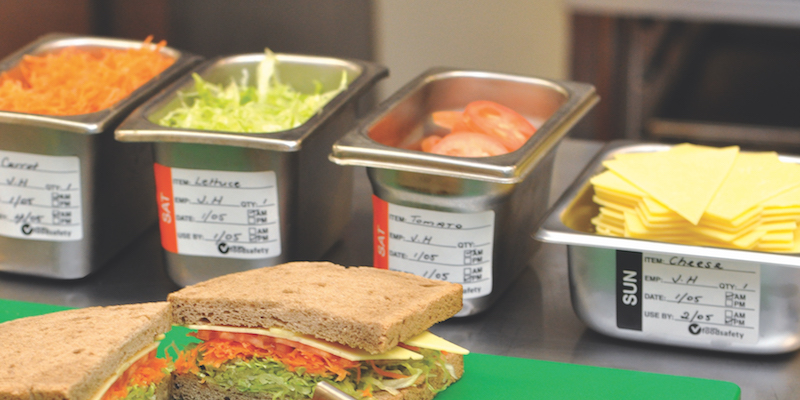10 Food Safety Storage Tips

Adopting a systematic approach to food safety in commercial kitchens and restaurants is essential for maintaining public safety. So here are 10 strategies designed to help chefs and restaurant and kitchen managers store food safely while ensuring it remains fresh and appetising.
1. First In, First Out. As deliveries or
prepared foods are stored, they need to be rotated so the dates with the
closest use-by are readily seen by staff who then know which to use first.
2.
Refrigeration
and Freezing. Cool rooms, freezers and refrigerators are machines that
require maintenance. As per the manufacturer’s instructions, establish a
process and schedule for checking they are functioning properly and maintaining
temperatures. When chilling food, this should be below 5C and when
freezing food below -18C. Do
not overcrowd your refrigerator or freezer. Air must circulate freely.
3. Separate Different Foods. Store raw
meats away from fresh fruit and vegetables. This will simplify the management
of your kitchen and reduce the spread of bacteria from one to the other. Store
prepared foods above raw foods in the fridge.
4. Store Food in Airtight Containers.
Airtight containers assist in reducing the spread of harmful bacteria in the
fridge and at room temperature. Ensure containers are clean and sanitary before
storing food in them.
5. Maintain Seals. An airtight container
is only as good as its seal. When washing, ensure seals are checked and discard
any with cracks or excessive signs of wear. Bacteria will grow in the cracks
and could easily spread to the contents of the container.
6. Get Organised. Use high quality labels to clearly indicate –
a. Use by dates,
b. Best before dates,
c. Contents,
d. Preparation dates,
e. Storage dates,
f. Who prepared it,
g. Ingredients contained within,
h. The contents contain known allergens,
i.
The food is suitable for vegans, vegetarians,
people with celiac disease and other conditions.
7. Use the Right Label Adhesive. When choosing
labels to indicate the above information, ensure the adhesive on those labels
is suited to its application and is of a food safety standard. Specific label
adhesives are manufactured to be either removable, permanent, dissolvable and
durable. Ensure the correct one is applied to suit the storage requirements of
the selected food.
8. Be Extra Cautious with High Risk Foods. The temperature danger zone with food is between 5C and 60C. Bacteria readily grows in this range. Dairy products, meat, seafood, prepared casseroles, roasts, stews and soups are high risk foods and must not be stored within this range.
a. Keep cool desserts, sliced meats, dairy products, sandwiches and salads below 5C.
b.
Keep roasts, stews, casseroles, curries and
soups above 60C.
9. Cover Food. This keeps dust, insects
and airborne bacteria away from food and is a simple technique for practicing
effective food safety.
10. Maintain Safe Temperatures of Displayed Foods. Displayed food is at particular risk of falling within the temperature danger zone. Using a quality food thermometer, periodically conduct temperature checks to see that displayed food is above 60C or below 5C.
Maintaining food safety standards for stored foods is an essential element for maintaining public health. Following the suggestions above will help chefs and restaurant and kitchen managers to protect their patrons and clients. However, it’s always a good idea to live by the maxim – if in doubt, throw it out!




















































































